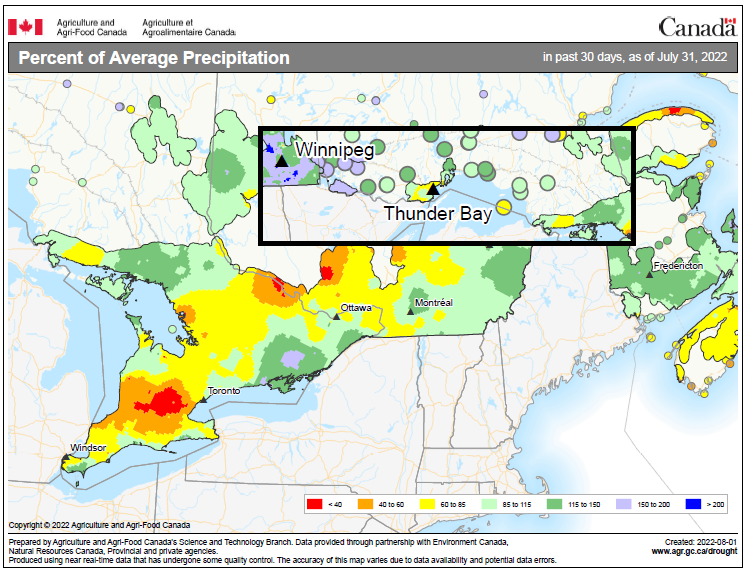Ontario Hay Listings is a free classifieds service provided by the Ontario Forage Council. Producers looking to buy or sell hay or straw are encouraged to post an ad.
The optimal time to summer seed alfalfa mixes depends on the length of the growing season:
- More than 3100 CHU: August 10-20
- 2700 – 3100 CHU: August 1-10
- Less than 2100 CHU: July 20 – August 1

South and West
- According to AAFC, most of the region received below average rainfall for July, with Waterloo and parts of Wellington, Hamilton-Wentworth and Peel being the driest counties. Some areas of Bruce, Essex, Elgin, Norfolk, and Niagara received normal amounts of precipitation.
- Potato leafhopper is the most economically significant alfalfa pest in Ontario. Hopperburn is frequently mistaken for insufficient water. Fields should be cut to stimulate regrowth and scouted again 5-7 days later to determine if insecticide is warranted.
- The fall rest period for alfalfa starts around August 25 for areas of Grey, Dufferin, Bruce, Huron, and Wellington counties, and later in other parts of the region. Cutting during the six weeks after this date depletes root reserves and increases the risk of winterkill.
Central and East
- According to AAFC, Prince Edward, Hastings, Lennox & Addington, and the western part of Stormont, Dundas & Glengarry received above-average rainfall for July. Muskoka, Haliburton, Kawartha Lakes, and Peterborough counties all received slightly less than normal amounts of precipitation, with Renfrew County being the driest in the region.
- Potato leafhopper is the most economically significant alfalfa pest in Ontario. Hopperburn is frequently mistaken for insufficient water. Fields should be cut to stimulate regrowth and scouted again 5-7 days later to determine if insecticide is warranted.
- The fall rest period for alfalfa starts around August 20 for areas of Renfrew, Haliburton, and Muskoka and later in other parts of the region. Cutting during the six weeks after this date depletes root reserves and increases the risk of winterkill.
Northeast
- According to AAFC, Manitoulin, Temiskaming, Cochrane, and Nipissing districts received average rainfall for July. Sudbury District had above-average levels of precipitation, and the eastern part of Algoma had below average rainfall for the month.
- Frequent showers have made hay harvest challenging in Algoma.
- The fall rest period for alfalfa starts around August 10 in Cochrane District, and later in areas further south. Cutting during the six weeks after this date depletes root reserves and increases the risk of winterkill. The fall rest period for birdsfoot trefoil begins about 10 days earlier than alfalfa.
Northwest
- According to AAFC, Rainy River and Kenora districts had above-average rainfall for July. Thunder Bay received average or below-average precipitation for the month.
- The fall rest period for alfalfa starts around August 10 in Kenora District, and later in areas further south. Cutting during the six weeks after this date depletes root reserves and increases the risk of winterkill. The fall rest period for birdsfoot trefoil begins about 10 days earlier than alfalfa.

Pasture Production
Four pasture sites across Ontario are participating in a precision agriculture project to use grass more efficiently. Each week grass growth rates, among other production metrics, are measured using a rising plate meter. Average daily grass growth rates are shared publicly, while more detailed information is available to participating pasture managers.
Year-to-date grass growth rates are shown in Figure 3.

Many thanks to Living Lab – Ontario, Ontario Beef Research Centre – Elora, Victoria County Community Pasture, and la Ferme d’éducation et de recherche du Campus d’Alfred (FERCA) for their involvement in this project.